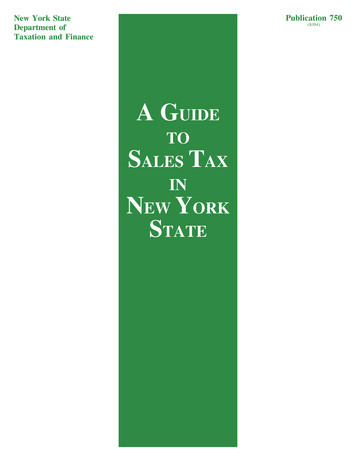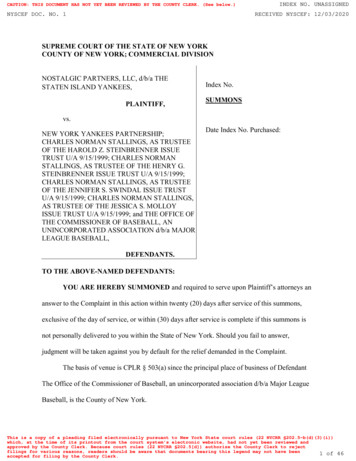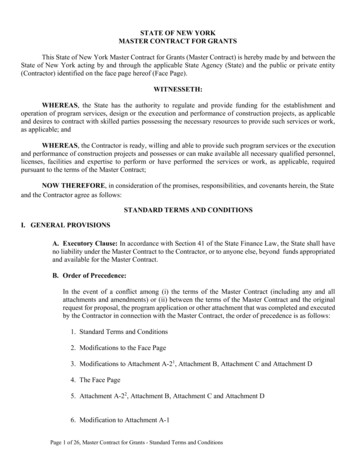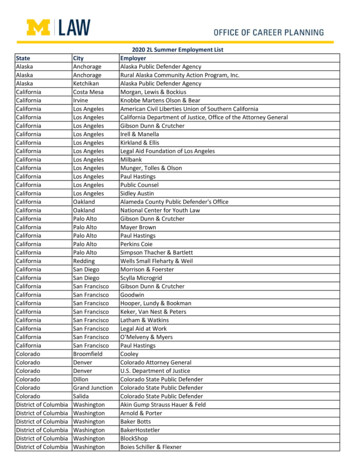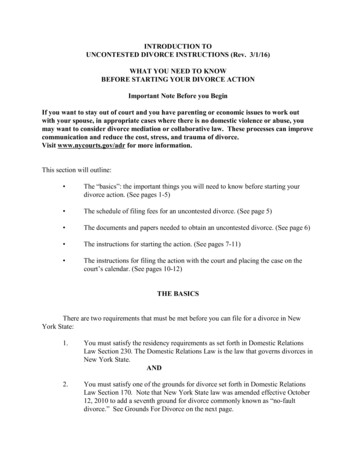
Transcription
INTRODUCTION TOUNCONTESTED DIVORCE INSTRUCTIONS (Rev. 3/1/16)WHAT YOU NEED TO KNOWBEFORE STARTING YOUR DIVORCE ACTIONImportant Note Before you BeginIf you want to stay out of court and you have parenting or economic issues to work outwith your spouse, in appropriate cases where there is no domestic violence or abuse, youmay want to consider divorce mediation or collaborative law. These processes can improvecommunication and reduce the cost, stress, and trauma of divorce.Visit www.nycourts.gov/adr for more information.This section will outline: The “basics”: the important things you will need to know before starting yourdivorce action. (See pages 1-5) The schedule of filing fees for an uncontested divorce. (See page 5) The documents and papers needed to obtain an uncontested divorce. (See page 6) The instructions for starting the action. (See pages 7-11) The instructions for filing the action with the court and placing the case on thecourt’s calendar. (See pages 10-12)THE BASICSThere are two requirements that must be met before you can file for a divorce in NewYork State:1.You must satisfy the residency requirements as set forth in Domestic RelationsLaw Section 230. The Domestic Relations Law is the law that governs divorces inNew York State.AND2.You must satisfy one of the grounds for divorce set forth in Domestic RelationsLaw Section 170. Note that New York State law was amended effective October12, 2010 to add a seventh ground for divorce commonly known as “no-faultdivorce.” See Grounds For Divorce on the next page.
Page 2 of 44 Rev. 3/1/16RESIDENCYTo file for a divorce in New York you must satisfy one of the following residency requirements:1. You or your spouse must have been living in New York State for a continuous period of atleast two years immediately before the date you start your divorce action; OR2. You or your spouse must have been living in New York State on the date you start yourdivorce action and for a continuous period of at least one year immediately before thedate you start the divorce action, and at least one of the following must also be true:a) Your marriage ceremony was performed in New York State; ORb) You lived in New York State with your spouse as married persons; OR3. You or your spouse must have been living in New York State for a continuous period of atleast one year immediately before the date you start your divorce action and your groundsfor divorce must have happened in New York State. (“Grounds” means a legal reason forthe divorce); OR4. You and your spouse must be residents of New York State (no matter how long) on thedate you start your divorce action, and your grounds for divorce must have happened inNew York State. (“Grounds” means a legal reason for the divorce).DEFINITION OF PLAINTIFF AND DEFENDANTWhere you are the person seeking the divorce, you are the Plaintiff and your spouse is called theDefendant.GROUNDS FOR DIVORCEIn order to file for a divorce in New York State you must have a ground (a legally acceptablereason) for the granting of a divorce by the New York courts. The seven legally acceptablereasons, or grounds for divorce, in New York are described in Domestic Relations Law §170.Listed with the most recently enacted no-fault divorce ground first and then following the orderlisted in the Domestic Relations Law, they are:DRL §170 (7) irretrievable breakdown in relationship for a period at least six months (commonlyknown as “no-fault divorce”);DRL §170 (1) cruel and inhuman treatment;DRL §170 (2) abandonment;DRL §170 (3) imprisonment;DRL §170 (4) adultery;DRL §170 (5) living separate and apart pursuant to a separation judgment or decree;DRL §170 (6) living separate and apart pursuant to a separation agreement
Page 3 of 44 Rev. 3/1/16THE NEWEST GROUND: COMMONLY CALLED “NO-FAULT DIVORCE”IRRETRIEVABLE BREAKDOWN IN RELATIONSHIP DRL §170 (7) To get a divorce on this ground, your relationship with the Defendant must have brokendown irretrievably (so that it is impossible to repair or reconcile) for a period of at leastsix months.This type of divorce is not automatic even though it is commonly called “no-faultdivorce.” The court will not grant you a divorce based on this ground unless anduntil:a) one of the parties has sworn under oath that the relationship has broken downirretrievably for a period of at least six months; ANDb) you and your spouse have either resolved all the economic issues of distribution ofproperty, maintenance, child support, and counsel and/or experts fees and expenses,and the custody and visitation with the minor children of the marriage OR theseissues have been decided by the court and incorporated into the final judgment ofdivorce.THE OTHER GROUNDS LISTED IN THE DOMESTIC RELATIONS LAWCRUEL AND INHUMAN TREATMENT DRL §170 (1) The treatment of the Plaintiff by the Defendant must rise to the level that thephysical or mental well being of the Plaintiff is endangered and making it unsafeor improper for the Plaintiff to continue living with the Defendant. You cannot obtain a divorce on this ground simply because you have argumentsor because of an isolated act in an otherwise long and peaceful marriage. If all or some of the acts occurred more than five years ago and your spouseopposes the divorce, your case may be dismissed. In describing the specific acts of cruelty, you must be clear and to the point. Youmust supply the court with details like dates and places. If you do not rememberthe exact date, use the words "on or about". After describing the acts of cruelty you should conclude with the followinglanguage: "The conduct of the Defendant was cruel and inhuman and soendangered the physical or mental well being of the Plaintiff as to render it unsafe
Page 4 of 44 Rev. 3/1/16or improper for the Plaintiff to cohabit with the Defendant.ABANDONMENT DRL §170 (2) An action for divorce may be maintained where the Defendant abandons the Plaintifffor a period of one year or longer prior to commencing the action and continuing to thepresent. Abandonment may take the form of your spouse physically departing your marital homewithout any intention of returning for a period of one year or longer prior tocommencing the action, and continuing to the present, without any good reason fordoing so and without your consent. Another form of abandonment is called constructive abandonment, which involves onespouse's refusal to engage in sexual relations with the other spouse continuously for oneyear or longer prior to commencing the action, and continuing to the present, withoutconsent, good cause or justification and despite your repeated requests. Another form of abandonment is called a lock out, which involves one spouse's refusalto allow the other spouse into the home continuously for more than one year prior tocommencing the action and continuing to the present.IMPRISONMENT DRL §170 (3) An action for divorce may be maintained by Plaintiff only where the Defendant isimprisoned for a period of at least three consecutive years. The imprisonment must havecommenced after the date of the marriage. If your spouse was released more than fiveyears ago and your spouse opposes the divorce, your case may be dismissed.ADULTERY DRL §170 (4) An action for divorce may be maintained based on adultery, which is an act of sexual ordeviate sexual intercourse voluntarily performed by the Defendant with a person otherthan his or her spouse during the course of the marriage. The ground of adultery can be difficult and expensive to prove because the testimony ofthe Plaintiff is not enough and other evidentiary requirements must be satisfied (theDefendant's admission is not enough). A corroborating affidavit of a 3rd party witness orother proof should be attached to the papers you submit to the court. You should keep inmind that acts of adultery may qualify as acts of cruelty and entitle you to maintain adivorce action on the grounds of cruel and inhuman treatment. Note: if you found out about the adultery more than five years ago and your spouseopposes the divorce, your case may be dismissed.
Page 5 of 44 Rev. 3/1/16CONVERSION OF A JUDGMENT OF SEPARATION DRL §170 (5) This ground is not used often. It involves a judgment of separation of the Supreme Court. To maintain a divorce action the parties are required to live separate and apart. They mustsatisfy the terms of the judgment of separation for more than one year after the judgment wasgranted.CONVERSION OF A WRITTEN SEPARATION AGREEMENT DRL §170 (6) A separation agreement is an agreement between the spouses that sets forth the terms andconditions by which the parties will live apart. The agreement must be signed by the partiesbefore a notary and filed with the County Clerk in the county where one of the parties resides. If you and your spouse have lived apart for more than one year according to the terms andconditions of a properly executed separation agreement, you may maintain an action fordivorce. It may be advisable to consult an attorney regarding this ground for divorce.After you have determined that you have met the requirements for residency and grounds fordivorce, you may use the forms in this packet to file for a divorce. The instructions in this packet will helpyou in completing these forms, starting your action and satisfying the other requirements for obtaining adivorce.SCHEDULE OF FILING FEES Index Number - 210.Note of Issue - 125 or 30.Request for Judicial Intervention - 95 or no fee.Note: 125 is the total fee for the Note of Issue plus the Request for JudicialIntervention. Please check with your county. Certificate of Dissolution - Check with your local County Clerk's Office Certified Copy of Judgment - Approx. 4. - 10.Check with the County Clerk's Office regarding acceptable forms of payment.POOR PERSON STATUSWhere an individual lacks the financial resources to pay the costs associated with a divorceaction, an application may be made to have these fees waived or forgiven by the court. The SupplementalAppendix of Forms in this booklet (beginning at page 35) contains instructions on how to complete theforms that are required to apply to have the fees waived.
Page 6 of 44 Rev. 3/1/16THE PAPERS NEEDED TO OBTAIN AN UNCONTESTED DIVORCE IN NEW YORK STATE:Notice of Automatic OrdersNotice of Guideline Maintenance for actions commenced on or after 1/25/16Notice Concerning Continuation of Health Care Coverage1) Summons With Notice (Form UD-1) OR 1a) Summons (to be served with VerifiedComplaint) (Form UD-1a)2) Verified Complaint (Form UD-2)3) Affidavit of Service (Form UD-3)4) Sworn Statement of Removal of Barriers to Remarriage (Form UD-4)and Affidavit of Service (Form UD-4a)5) Affirmation (Affidavit) of Regularity (Form UD-5)6) Affidavit of Plaintiff (Form UD-6)7) Affidavit of Defendant (Form UD-7)8(1)Annual Income Worksheet (Form UD-8(1)8(2) Maintenance Guidelines Worksheet (Form UD-8(2)for divorces commenced on or after 1/25/168(3)) Child Support Worksheet (Form UD-8-(3))8a) Support Collection Unit Information Sheet (Form UD-8a)8b) Qualified Medical Child Support Order ("QMCSO") (Form UD-8b)9) Note of Issue (Form UD-9)10) Findings of Fact/Conclusions of Law (Form UD-10)11) Judgment of Divorce (Form UD-11)12) Part 130 Certification (Form UD-12)13) Request for Judicial Intervention("RJI") (Form UD-13) and Addendum (Form 840M)14) Notice of Entry (Form UD-14)15) Affidavit of Service of Judgment of DivorceCertificate of Dissolution of MarriageSelf-Addressed and Stamped PostcardUCS-111 (UCS Divorce and Child Support Summary Form)SUPPLEMENTAL APPENDIX OF FORMSA. Income Withholding Order and Applying for Child Support ServicesA-1 Application for Child Support Services*A-2 Income Withholding Order form for Child Support and Combined Child and Spousal Support LDSS-5037 (Non-IV-D IWO)A-2A Income Withholding Order Form for Spousal Support only - LDSS-5038 (Spousal Support OnlyIWO)(Important Note: LDSS-5037 and LDSS-5038 are the actual Forms)A-2B Income Withholding for Support: General Information and Instructions for Issuing - LDSS-5039*(Important Note: Do not complete this form. Use it as a guide when filling out the actual Forms. )B. New York State Case Registry Filing Form with Instructions attachedC. Notice of SettlementD. Poor Person OrderE. Affidavit in Support of Application to Proceed as a Poor PersonF. Affidavit of Service of Proposed Poor Person’s Order*available at http://www.nycourts.gov/divorce/divorce withchildrenunder21.shtml
Page 7 of 44 Rev. 3/1/16The instructions for completing each individual form begin at page 13 and gothrough the end of this PacketA COPY OF EACH COMPLETED FORM SHOULD BE RETAINED FOR YOUR RECORDS.STARTING THE DIVORCE ACTION:1.This packet should be filled out either by typing or printing the information. Printing should belegible and in BLACK ink only.2.If you need additional space on any form, you may use an addendum sheet. Be sure to note on theparticular form that an additional sheet is being attached to that form.3.Attach to your papers any court orders regarding this marriage and child support/custody/visitation.All unemancipated children of the marriage are entitled to receive child support. The court mustdecide custody and visitation of all minor children of the marriage. Whenever these instructionsand forms refer to:(i) “children of the marriage,” they include all children under the age of twenty one born to oradopted by the parties before or during the marriage.(ii)“unemancipated children,” they include all children of the marriage under the age of twentyone born to or adopted by the parties before or during the marriage and entitled to child support.Upon sufficient proof, a court might consider a child under the age of twenty one “emancipated”and therefore not entitled to support if the child marries, enters the military, or is at least eighteenyears old and is self-supporting. It is up to the court to decide whether the child is emancipated.(iii)“minor children of the marriage,” they include all children under the age of eighteen born toor adopted by the parties before or during the marriage.4.Please refer to the attached glossary, which defines many of the other terms and phrases used inthis packet.IF YOU ARE CONCERNED ABOUT DOMESTIC VIOLENCE AND WISH TO KEEP YOURADDRESS CONFIDENTIAL, PLEASE CHECK WITH THE SUPREME COURT CLERK’SOFFICE FOR INSTRUCTIONS ON HOW TO OBTAIN CONFIDENTIALITY. IFCONFIDENTIALITY IS GRANTED BY THE COURT, YOU SHOULD NOT FILL OUT YOURADDRESS OR OTHER PRIVATE INFORMATION ON ANY OF THESE FORMS.
Page 8 of 44 Rev. 3/1/16FOLLOW STEPS 1-7 TO START THE DIVORCE ACTIONSTEP 1: Prepare an original and two copies of the Summons With Notice (Form UD-1) or theSummons and Verified Complaint (Form UD-1a and Form UD-2).STEP 2: Purchase an index number at the County Clerk's Office and file the original of the SummonsWith Notice or the original of the Summons and Verified Complaint with the County Clerk.Unless you are granted a poor person's waiver, you will be required to pay 210 for the indexnumber. Check with the County Clerk regarding acceptable forms of payment. Many CountyClerks also will require that you fill out an Index Number Application Form at the time of filing,so be sure to bring with you the names, addresses and telephone numbers of all of the attorneysor, if unrepresented, of the parties themselves.STEP 3: Put the index number and the date of the filing on the two copies of the Summons WithNotice (or the Summons and Verified Complaint) if this is not done by a clerk upon filing thepapers.STEP 4: Where the Defendant agrees to the divorce, he or she will need to sign the Affidavit ofDefendant (Form UD-7). This may be done by submitting the form to the Defendant togetherwith the Summons With Notice or Summons and Verified Complaint and Notice of AutomaticOrders and Notice of Guideline Maintenance, if the divorce was commenced on or after1/25/16. The Plaintiff should send the form to the Defendant with a copy of the instructions onhow to fill it out. The Defendant must send the completed form back to the Plaintiff prior tohaving the case placed on the calendar so that the form can be filed with the other forms. If theDefendant does not return the signed form to Plaintiff, follow STEP 5 below.STEP 5: Have the Defendant served with one copy of the Summons With Notice or Summons andVerified Complaint, and the Notice of Automatic Orders, the Notice of Guideline Maintenance,,if the divorce was commenced on or after 1/25/16, and the Notice Concerning Continuation ofHealth Care Coverage, by being personally handed the papers. NOTE: The MaintenanceGuidelines apply only to divorces commenced on or after 1/25/16, and therefore you should notserve the Notice of Guideline Maintenance with the Summons if your divorce was commencedbefore 1/25/16. “Maintenance” means support paid by one party to the marriage(“spouse”) for the support of the other party pursuant to a final Judgment of Divorce.If your spouse lives in New York State: The server must be a resident of New York State, overeighteen years of age, and cannot be a party to the action (this means you may not serve your spousewith the Summons).
Page 9 of 44 Rev. 3/1/16 If your spouse is presently residing outside of New York State: You must still ensure that he or sheis personally served with the summons. If you use a non-New York State resident to serve your spouseoutside of New York State, the server must be a person authorized to make service pursuant to the lawsof that jurisdiction or a duly qualified attorney in that jurisdiction, and you must submit a copy of theauthorization that allows that person to serve the summons. You are encouraged to check with the localsheriff and, if necessary, with a country's Consulate or Embassy as to any local requirements for service.Service upon the Defendant of the Summons With Notice or Summons and Verified Complaint andNotice of Automatic Orders must be made within 120 days of their filing with the County Clerk'sOffice. If you do not know where the Defendant is located, you may wish to delay filing the Summons WithNotice or Summons and Verified Complaint until he or she is located, so that the 120-day period does notbegin running while you search for your spouse.IMPORTANT: The Notice of Guideline Maintenance must also be served with the Summons WithNotice or Summons and Verified Complaint BUT ONLY if Your Action Was Commenced on or afterJanuary 25, 2016.IMPORTANT: If there are children of the marriage under the age of 21 (see the definition on page 7),you must also serve a copy of the Child Support Standards Chart on the Defendant. The Chart isavailable at:https://newyorkchildsupport.com/quick links.htmlSTEP 6: If you had to follow STEP 5 above because the Defendant would not agree to complete and returnthe Affidavit of Defendant, the person that served the Defendant must prepare an "Affidavit ofService" (Form UD-3), which attests to the service of the Summons With Notice or Summonsand Verified Complaint, Notice of Automatic Orders, Notice of Guideline Maintenance if thedivorce was commenced on or after 1/25/16, and any other documents served. This affidavit must besubmitted along with the full set of divorce papers when you place your case on the court's calendar.There is a 40-day waiting period from date of service to place the matter on the court's calendar. Ifthe Defendant does not sign Form UD-7 to waive the 40 day period, you must wait the full 40 days.STEP 7: If the parties were married in a civil ceremony or if the Defendant signs the Affidavit ofDefendant (Form UD-7), SKIP THIS STEP. If the parties were married in a religiousceremony, the Defendant must be served with a copy of the Sworn Statement of Removal ofBarriers to Remarriage (Form UD-4). The Plaintiff must fill out the original and make a copy ofthe form. The copy then must be served on the Defendant either by personal service along with theSummons With Notice or the Summons and Verified Complaint, or by mail. If you serve the formby mail, it must be done prior to your placing your action on the court's calendar, because you willneed to file the original form with the other required forms. Service by mail must be done bysomeone other than the Plaintiff who is over the age of 18 and not a party to the action. When youfile this form, you must attach to the form the Affidavit of Service (Form UD-4a).
Page 10 of 44 Rev. 3/1/16If the Defendantto this action:* Then your matter is no longer an uncontested matrimonial and you will be unable toobtain an uncontested divorce. You may want to consult an attorney at that point.STEPS FOR PLACING YOUR DIVORCE CASE ON THE COURT CALENDARAfter you have completed Steps 1-7, you are ready to place your case on the court's calendar. If the Defendantconsents to the action by signing the Affidavit of Defendant (Form UD-7), you may place your case on thecourt's calendar immediately. Otherwise, you will have to wait until 40 days after the date of the service of thesummons.You must complete the following steps to place your case on the calendar:STEP 8: You must complete Forms UD-3 through UD-12 (include UD-7 only if signed by the Defendant).Form UD-3 (Affidavit of Service) and Form UD-4 (Sworn Statement of Removal of Barriers to Remarriage)need not be completed, or filed, if the Defendant has signed Form UD-7 (Affidavit of Defendant) and checkedBox 6b on the form, Form UD-8(3) Child Support Worksheet, Form UD-8a (Support Collection UnitInformation Sheet) and Form UD-8b (Qualified Medical Child Support Order) need not be completed, orfiled, if there are no unemancipated children of the marriage (see the definition on page 7). Form UD-8(2)(Maintenance Guidelines Worksheet) need not be completed or filed if neither party seeks maintenance aspayee under the Maintenance Guidelines Law. Form UD-8(1) (Annual Income Worksheet) is not required ifneither party seeks maintenance or child support.STEP 9: You also must complete the Request for Judicial Intervention (Form UD-13) and, if there arechildren under the age of 18 who are subject to the matrimonial action, the Addendum Form 840M.STEP 10: You also must complete the Certificate of Dissolution of Marriage, the postcard, and,where applicable, the UCS 111 (Divorce and Child Support Summary Form). If a party is requesting childsupport payable to a person or entity other than a child support collection unit, the party must complete, aswell, the New York State Case Registry Form.STEP 11: You must file the completed forms, including a copy of the Summons With Notice or the Summonsand Verified Complaint, with the County Clerk's Office. Include three (3) copies of the Note of Issue (FormUD-9).
Page 11 of 44 Rev. 3/1/16STEP 12:Unless you are granted a poor person's waiver, you must pay a filing fee for filing the Note ofIssue (Form UD-9) and the Request for Judicial Intervention (Form UD-13). See page 5 for theschedule of filing fees.All of the papers filed with the County Clerk's Office will be submitted to the judge. If the papers areapproved, the judge will sign the Judgment of Divorce (Form UD-11).If you are asking for maintenance, custody, visitation, or distribution of property, the court mayrequire a hearing, even if there is a prior court order or a prior agreement between you and yourspouse. If there is no prior court order or agreement, you and your spouse can try to settle theseissues by signing a written agreement , but any agreement with your spouse is subject to judicialapproval prior to the court issuing a Judgment or an order incorporating the parties' agreement.Prior to making a decision about approval of the agreement, the court may also require a hearing.The court will notify you and your spouse to appear, if a hearing is required.SUPPLEMENTAL FORMSThis packet contains additional forms that you may be required to file depending upon the specialrequirements in the county where you are bringing the action.a. Income Withholding Order / Child Support ServicesWhen MUST the Court Issue an Income Withholding OrderWhen the Court issues an order of support, the Court must in every case issue an immediate incomewithholding order unless:i) child support services are being applied for, or provided through, the child support enforcement program(often referred to as the “IV-D” program) from a local district Support Collection Unit; orii) the Court finds and sets forth in writing (1) the reasons why there is good cause not to require immediateincome withholding, or (2) an agreement providing for an alternative arrangement has been reached betweenthe parties. See Domestic Relations Law § 240(2)(b)(2), Family Court Act § 440(1)(b)(2), and CPLR § 5242 Where an income withholding order is required, the Court shall direct that the support be paid byautomatically deducting moneys from the paying spouse’s income through the use of an Income WithholdingOrder.The child support program (often referred to as the “IV-D” program) is a state-supervised, county-run program.Each local social services district has a Support Collection Unit that assists litigants in obtaining the childsupport (or enforcing child and spousal support combined) that has been ordered by the court.To learn about and apply for child support services, use Form LDSS - 4882. You may download a copyof this form from the Divorce Resources website of the New York State Unified Court System under ChildSupport Resources at http://www.nycourts.gov/divorce/. The application form has two sections. The firstsection provides a detailed description of the child support services provided and other importantinformation you need to know. A child support brochure (Pub.1950) is also available that provides a briefdescription of the program which may also be found at the court website.
Page 12 of 44 Rev. 3/1/16As an alternative to using Form LDSS 4882, you may also apply for child support services by using thePlaintiff’s Affidavit (Form UD-6). See instructions at Field 20.If you wish to apply for child support services at this time, or you are already receiving such services,DO NOT fill out this Income Withholding Order; an Income Withholding Order will be prepared and sent bythe Support Collection Unit on your behalf.If you do not wish to apply for child support services at this time, you may choose to apply for suchservices through your local Support Collection Unit in the future.If you do not apply for child support services at this time, and are not already receiving them, the Court maynonetheless decide after consideration of relevant factors that an Income Withholding Order is required bylaw.If the Court notifies you that an Income Withholding Order is required, or you decide to ask the Court to issueone, follow the procedure for completing and serving the Income Withholding Order set forth in theSupplemental Appendix of Forms Instructions, and submit the order to the Supreme Court Clerk's Office.b. Notice of SettlementIn some instances, the court will not sign the Judgment of Divorce until the Defendant is served with acopy of the unsigned Judgment and any other proposed orders and is permitted an opportunity to object toor comment on them. In that situation, the court will notify you that the Judgment and the proposed ordersare to be served upon the Defendant with a Notice of Settlement (see Supplemental Appendix of Forms atpage 34). Follow the procedure set forth in the Supplemental Appendix of Forms for completing and servinga Notice of Settlement.AFTER THE JUDGMENT HAS BEEN SIGNED BY THE COURTThe Judgment of Divorce (Form UD-11) needs to be filed and entered in the County Clerk’s Office. Themanner in which this occurs depends upon the procedure of the county in which you brought the action.Consult the Supreme Court Clerk's Office for information regarding your obligations for the retrieval and/orentry of the signed judgment and supporting papers. Should you receive notice that the papers have been filedon your behalf by the court, or if you file the papers, you may go to the County Clerk's Office to obtain acertified copy of the judgment. You must bring identification with you, because matrimonial files areconfidential and information will be released only to a party or his or her attorney. The certified copy will costbetween 4.00 and 10.00, but the fee will be waived if you obtained a poor person waiver. A copy of thejudgment of divorce must be served on the Defendant. To do this, you must have served on the Defendant acopy of the signed and entered Judgment of Divorce (Form UD-11), together with the completed Notice ofEntry (Form UD-14). Service by mail is sufficient.You should ask the person who serves the Judgment ofDivorce with Notice of Entry to sign the Affidavit of Service of Judgment of Divorce (Form UD-15) beforea Notary Public. A copy of the Judgment of Divorce and Notice of Entry must be attached to the signed andnotarized Affidavit of Service. Keep the Affidavit with your important papers.TURN TO PAGES 13 - END FOR INSTRUCTIONS ON HOW TO COMPLETE THE FORMS
Page 13 of 44 Rev. 3/1/16FORMS INSTRUCTIONSIf you have unemancipated children of the marriage under the age of twenty one (see the definition on page 7),please see the Annual Income Worksheet (Form UD-8(1) Instructions and the Child Support Worksheet (FormUD-8(3)) Instructions before you prepare the summons, so you can give the Defendant notice of the amount of childsupport demanded.1.SUMMONS WITH NOTICE (Form UD-1):This form is used when commencing an action for divorce without a Verified Complaint. The Notice of AutomaticOrders, Notice of Guideline Maintenance if the divorce was commenced on or after 1/25/16, and ChildSupport Standards Chart if applicable must, and the Notice Concerning Continuation of Health CareCoverage should, be served with the Summons with Notice. Note: if your action was commenced beforeJanuary 25, 2016 , the Maintenance Guidelines Law will not apply.Field 1:
The schedule of filing fees for an uncontested divorce. (See page 5) The documents and papers needed to obtain an uncontested divorce. (See page 6) The instructions for starting the action. (See pages 7-11) The instructions for filing the action with the court and placing the case on the court's calendar. (See pages 10-12) THE .






